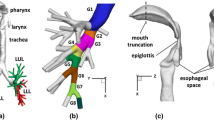Abstract
Two mathematical models of pulmonary single breath gas washout (one analytic, one numerical) are developed and their predictions compared with experimental data on human subjects. Weibel's 23 generation symmetric anatomical model is used as a guide to bronchial tree geometry. Experimental plots of nitrogen concentration versus volume expired, dead space versus breath holding time, and dead space versus tidal volume are compared with plots predicted by the models. Agreement is good. A plot of nitrogen concentration in the airways as predicted by the numerical model at different times during inhalation and exhalation of a single breath of oxygen is shown. Model predictions for changes in dead space with changes in washout gas and expiratory flow rate are discussed. Use of the analytic model for obtaining average values of the path length from mouth to alveoli in a given subject is discussed. To the extent of their agreement with experiment, the models provide a sound physical basis for the correlation of airway structure and function.
Similar content being viewed by others
Literature
Cumming, G., J. Crank and I. Parker. 1966. “Gaseous Diffusion in the Air Ways of the Human Lung.”Respir. Physiol.,1, 58–74.
Evans, J.W. and D. G. Cantor. 1967. “The Dead Space in a Compartmental Lung Model.”Bull. Math. Biophysics,29, 711–718.
Fowler, W. S. 1952. “Intrapulmonary Distribution of Inspired Gas.”Physiol. Rev.,32, 1–20.
Horsfield, K. and G. Comming. 1967. “Angles of Branching and Diameters of Branches in the Human Bronchial Tree.”Bull. Math. Biophysics,29, 245–259.
La Force, R. C. and B. M. Lewis. 1970. “Diffusional Transport in the Human Lung.”J. Appl. Physiol.,28, 291–298.
Nye, R. E. 1961. “Theoretical Limits to Measurement of Uneven Ventillation.”J. Appl. Physiol.,16, 1115–1123.
Robertson, J. S., W. E. Siri and H. B. Jones. 1950. “Lung Ventilation Patterns Determined by Analysis of Nitrogen Elimination Rates; Use of the Mass Spectrometer as a Continuous Gas Analyzer.”J. Clin. Invest.,29, 577–590.
Scherer, P. W., S. T. Chiang and A. Bouhuys. 1970. “A Quantitative Model of Anatomic Dead Space.”Fed. Proc. Abs.,29, 396.
Schroter, R. C. and M. F. Sudlow. 1969. “Flow Patterns in Models of the Human Bronchial Airways.”Respir. Physiol.,7, 341–355.
Shepard, R. H., E. J. M. Campbell, H. B. Martin and T. Enns. 1957. “Factors Affecting the Pulmonary Dead Space as Determined by Single Breath Analysis.”J. Appl. Physiol.,11, 241–244.
Taylor, G. I. 1953. “Dispersion of Soluble Matter in Solvent Flowing Slowly Through a Tube.”Proc. Roy. Soc.,A219, 186–203.
Wehner, J. F. and R. H. Wilhelm. 1956. “Boundary Conditions of Flow Reactor.”Chem. Eng. Sci.,6, 89–93.
Weibel, E. R. 1963.Morphometry of the Human Lung. Berlin, Springer-Verlag.
Wilson, T. A. and K. Lin. 1970. “Convection and Diffusion in the Airways and the Design of the Bronchial Tree.” InAirway Dynamics Physiology and Pharmacology (pp. 5–19). Edited by Arend Bouhuys. Springfield, Illinois, Charles C. Thomas.
Author information
Authors and Affiliations
Rights and permissions
About this article
Cite this article
Scherer, P.W., Shendalman, L.H. & Greene, N.M. Simultaneous diffusion and convection in single breath lung washout. Bulletin of Mathematical Biophysics 34, 393–412 (1972). https://doi.org/10.1007/BF02476450
Received:
Issue Date:
DOI: https://doi.org/10.1007/BF02476450




